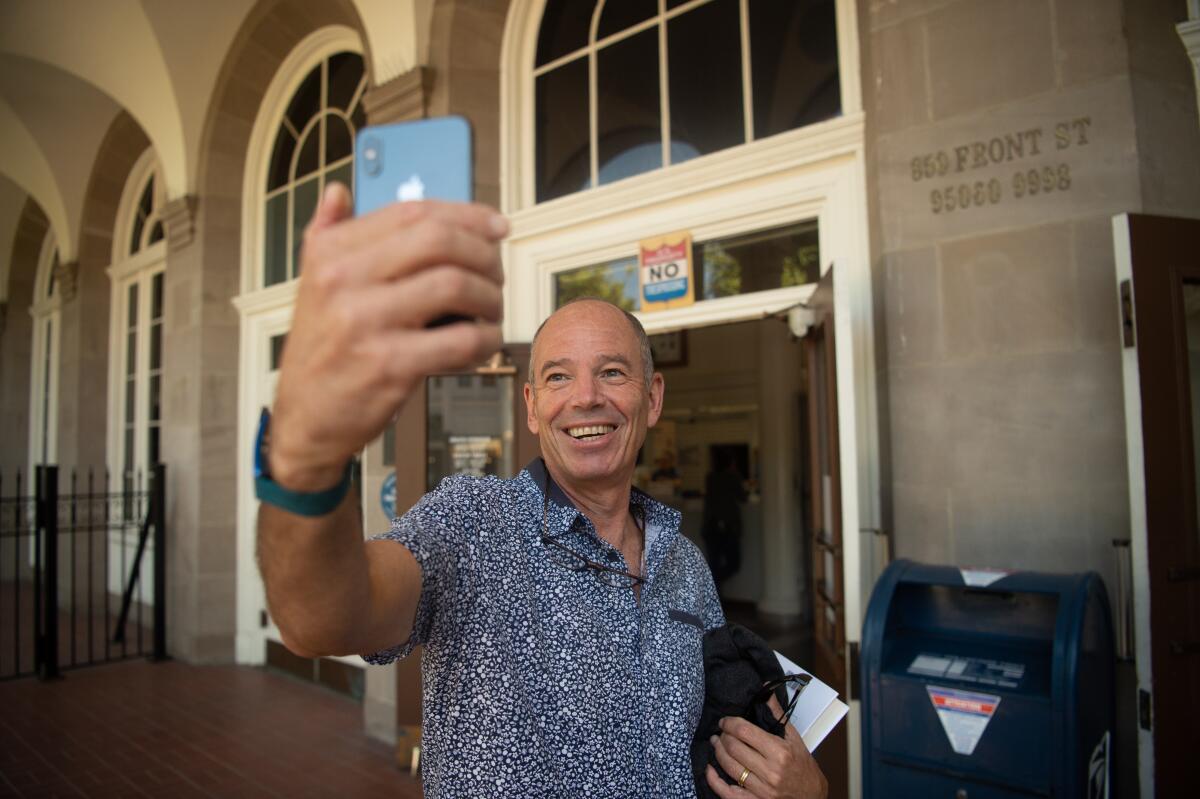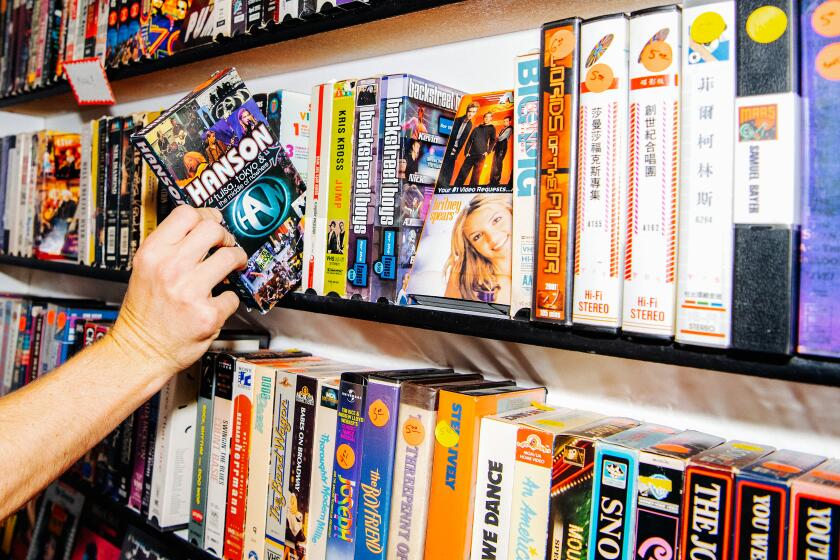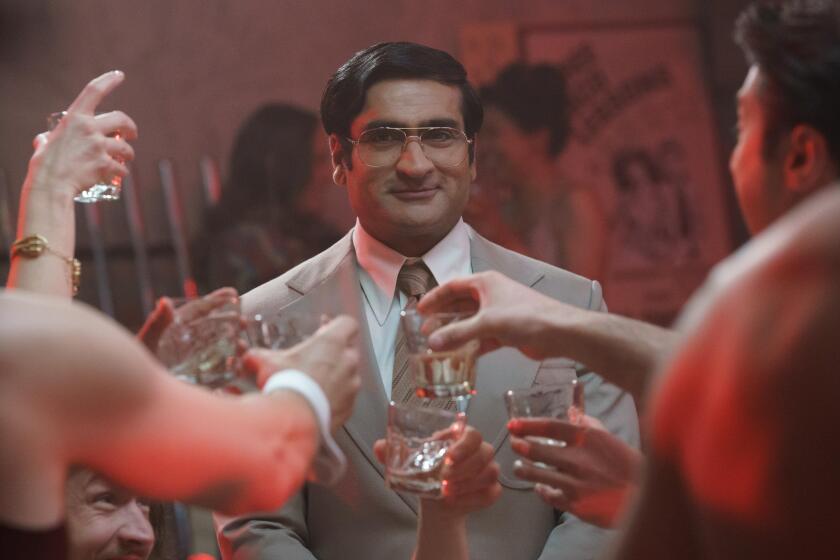Netflix’s DVD mail service still has die-hard fans. But is its demise near?

- Share via
SANTA CRUZ — Netflix’s trailblazing DVD-by-mail rental service is seen as a relic in the age of video streaming, but there is still a steady — albeit shrinking — audience of die-hards, including Amanda Konkle, who are happily paying to receive those discs in the iconic red-and-white envelopes.
“When you open your mailbox, it’s still something you actually want instead of just bills,” said Konkle, a resident of Savannah, Ga., who has been subscribing to Netflix’s DVD-by-mail service since 2005.
It’s a small pleasure that Konkle and other still-dedicated DVD subscribers enjoy, but it’s not clear for how much longer. Netflix declined to comment for this story, but during a 2018 media event, Netflix co-founder and co-Chief Executive Reed Hastings suggested the DVD-by-mail service might close around 2023.
When — not if — it happens, Netflix will shut down a service that has shipped more than 5 billion discs across the United States since its inception nearly a quarter-century ago. And it will echo the downfall of the thousands of Blockbuster video rental stores that closed because they couldn’t counter the threat posed by Netflix’s DVD-by-mail alternative.
The eventual demise of its DVD-by-mail service has been inevitable since Hastings decided to spin it off from a then-nascent video streaming service in 2011. Back then, Hastings floated the idea of renaming the service as Qwikster — a bungled idea so widely ridiculed that it was satirized on “Saturday Night Live.”
An L.A. couple with a love of obscure video tapes is bringing a dead medium back to life again.
It finally settled on its current, more prosaic handle, DVD.com. The operation is now based in a nondescript office in Fremont, Calif., about 20 miles from Netflix’s sleek campus in Los Gatos.
Shortly before its spinoff from video streaming, the DVD-by-mail service boasted more than 16 million subscribers, a number that has now dwindled to an estimated 1.5 million, all in the United States, based on calculations drawn from Netflix’s limited disclosures of the service in its quarterly reports. Netflix’s video streaming service now has 223 million worldwide subscribers, including 74 million in the United States and Canada.
“The DVD-by-mail business has bequeathed the Netflix that everyone now knows and watches today,” said Marc Randolph, Netflix’s original CEO, during an interview at a coffee shop across the street from Santa Cruz’s main post office.
The 110-year-old post office has become a landmark in Silicon Valley history because it’s where Randolph mailed a Patsy Cline CD to Hastings in 1997 to test whether a disc could be delivered through the U.S. Postal Service without being damaged.
The disc arrived at Hastings’ home unblemished, prompting the duo in 1998 to launch a DVD-by-mail rental website that they always knew would be supplanted by even more convenient technology.
“It was planned obsolescence, but our bet was that it would take longer for it to happen than most people thought at the time,” Randolph said.
With Netflix’s successful streaming service, it might be easy to assume that anyone still paying to receive DVDs through the mail is a technophobe or someone living in a remote part of the United States without reliable internet access. But subscribers say they stick with the service so they can rent movies that are otherwise difficult to find on streaming services.
For Michael Fusco, 35, that includes the 1986 film “Power,” starring a then-youthful Richard Gere and Denzel Washington, and 1980’s “The Big Red One,” starring Lee Marvin. That’s among the main reasons he has been subscribing to the DVD-by-mail service since 2006, when he was just a freshman in college, and he has no plans to cancel it now.
As Netflix grapples with a loss in subscribers, the company’s vaunted “team” culture is coming under strain as some employees worry about their future.
“I have been getting it for almost half my life, and it has been a big part,” Fusco said. “When I was young, it helped me discover voices I probably wouldn’t have heard. I still have memories of getting movies and having them blow my mind.”
Tabetha Neumann is among the subscribers who rediscovered the DVD service during the throes of the COVID-19 pandemic lockdowns in 2020 after running out of things to watch on her video streaming service. So she and her husband signed up again for the first time since canceling in 2011.
Now they like it so much that they get the plan that allows them to keep up to three discs at a time, an option that currently costs $20 a month (compared with $10 a month for the one-disc plan).

“When we started going through all the movies we wanted to see, we realized it was cheaper than paying $5 per movie on some streaming services,” Neumann said. “Plus we have found a lot of old horror movies, and that genre is not really big on streaming.”
Konkle, who has written a book about Marilyn Monroe’s films, says she still finds movies on the DVD service — such as the 1954 film “Cattle Queen of Montana,” featuring future President Reagan alongside Barbara Stanwyck, and the 1983 French film “Sugar Cane Alley” — that help her teach film studies classes as an associate professor at Georgia Southern University. It’s a viewing habit she doesn’t usually share with her classes because “most of my students don’t know what a DVD is,” said Konkle, 40, laughing.
But for all the DVD service’s attractions, subscribers are starting to notice signs of deterioration as the business has shrunk from producing more than $1 billion in annual revenue a year ago to an amount likely to fall below $200 million this year.
Audiences are spending hours rehashing true-crime stories, drawn to realism and nostalgia associated with ripped-from-the-headlines stories.
Katie Cardinale, a subscriber who lives in Hopedale, Mass., said she now has to wait an additional two to four days for discs to arrive in the mail because they are shipped from a distribution center in New Jersey instead of Boston. (Netflix doesn’t disclose how many DVD distribution centers still operate, but there were once about 50 in the United States.)
Konkle said more discs now come with cracks or other defects and it takes “forever” to get them replaced. And almost all subscribers have noticed the selection of DVD titles has shrunk dramatically from the service’s peak years when Netflix touted it had more than 100,000 different movies and TV shows on disc.
Netflix no longer discloses the size of its DVD library, but the subscribers interviewed by the Associated Press all reported that the narrowing selection is making it more difficult to find famous films and popular TV series that once were routinely available on the service. Instead, Netflix now sorts requests for titles such as the first season of the award-winning “Ted Lasso” series — a release that can be purchased on DVD — into a “saved” queue, signaling it may decide to stock the title in the future, depending on demand.
Recognizing that the end is in sight, Randolph said he will lament the death of the DVD service he brought to life while taking comfort in knowing its legacy will survive.
“Netflix’s DVD business was part and parcel of who Netflix was and still is,” he said. “It’s embedded in the company’s DNA.”
More to Read
Inside the business of entertainment
The Wide Shot brings you news, analysis and insights on everything from streaming wars to production — and what it all means for the future.
You may occasionally receive promotional content from the Los Angeles Times.













